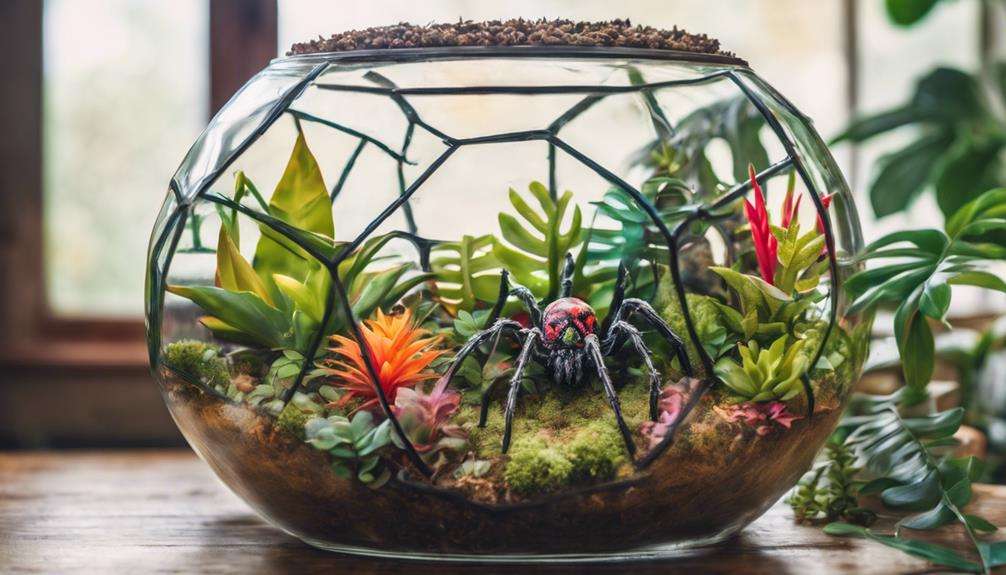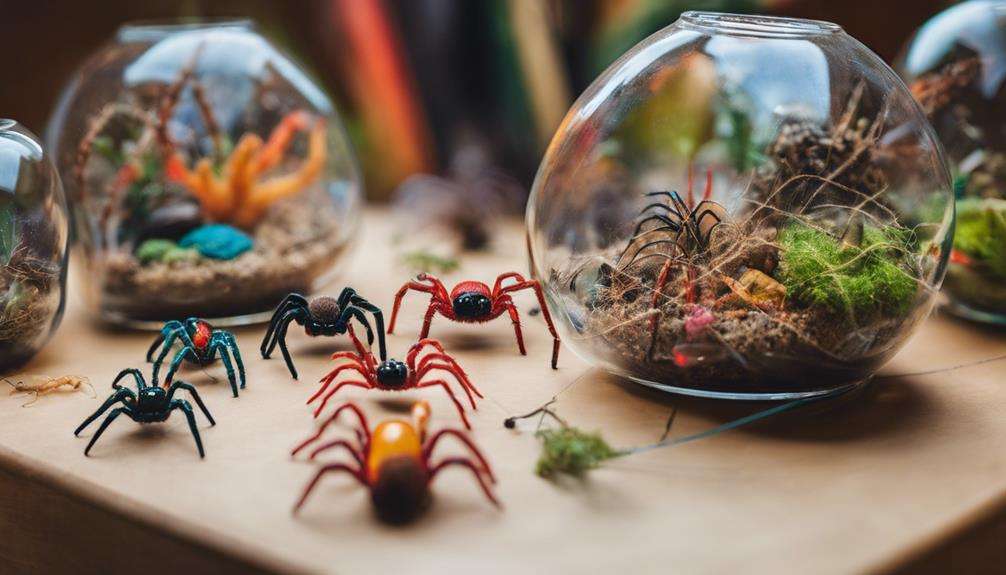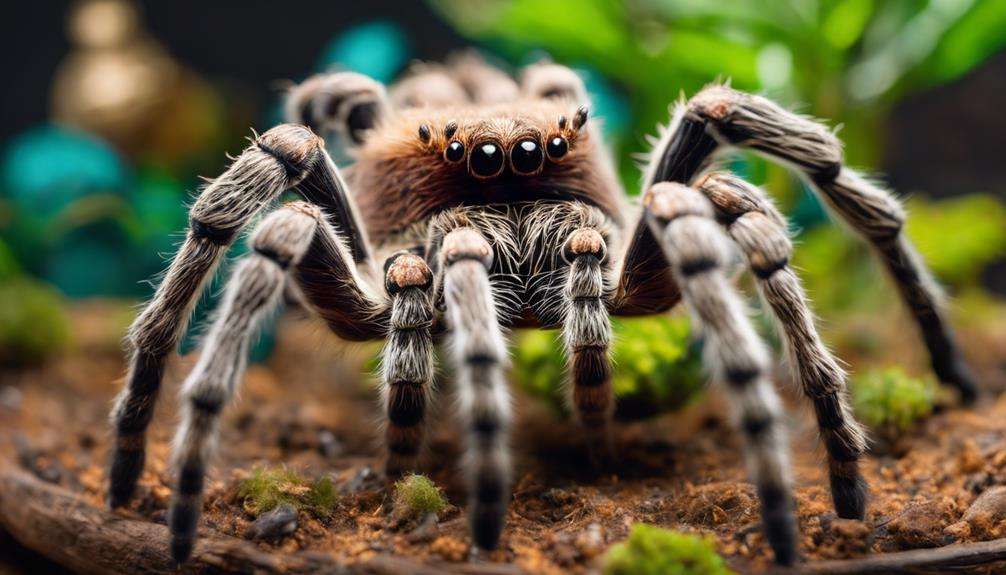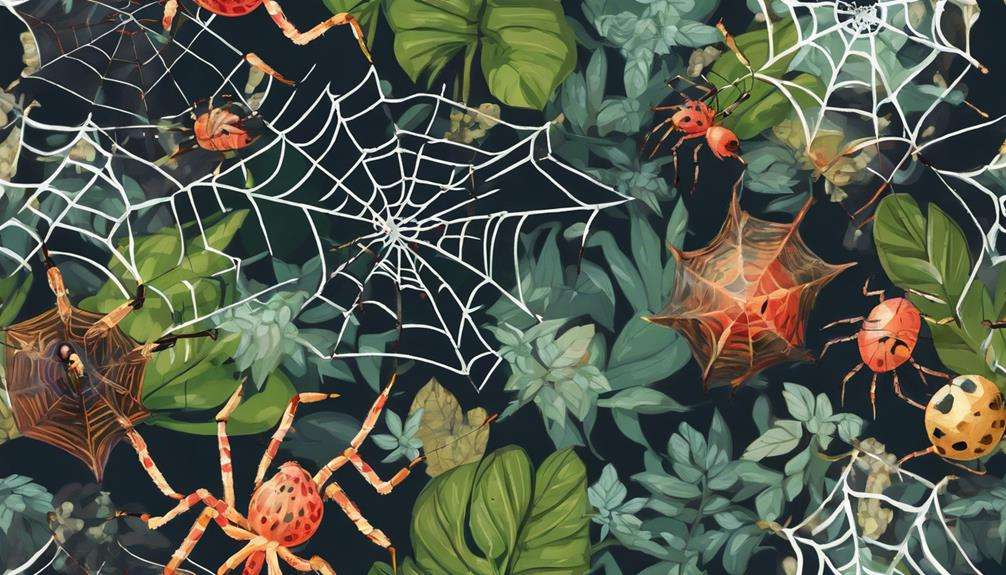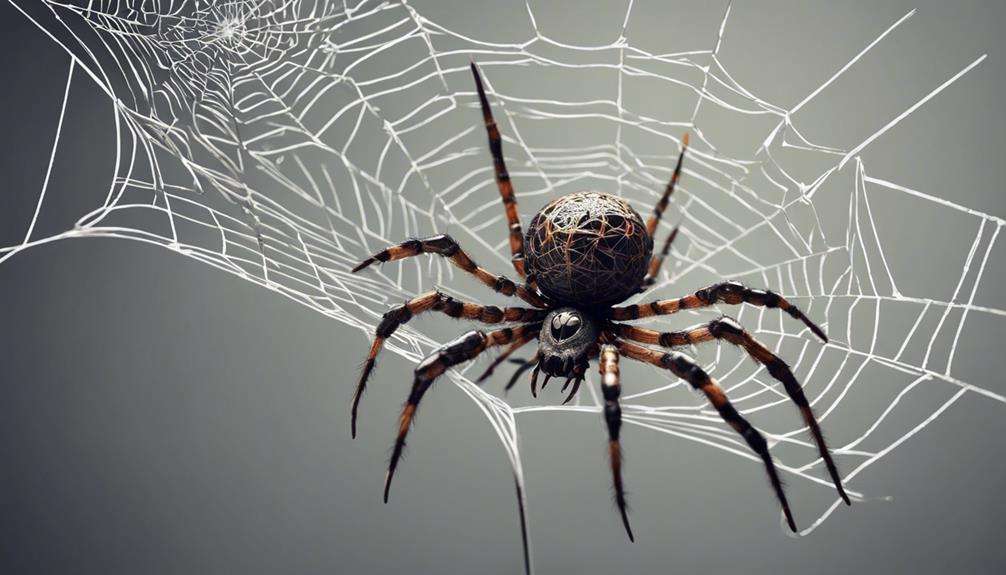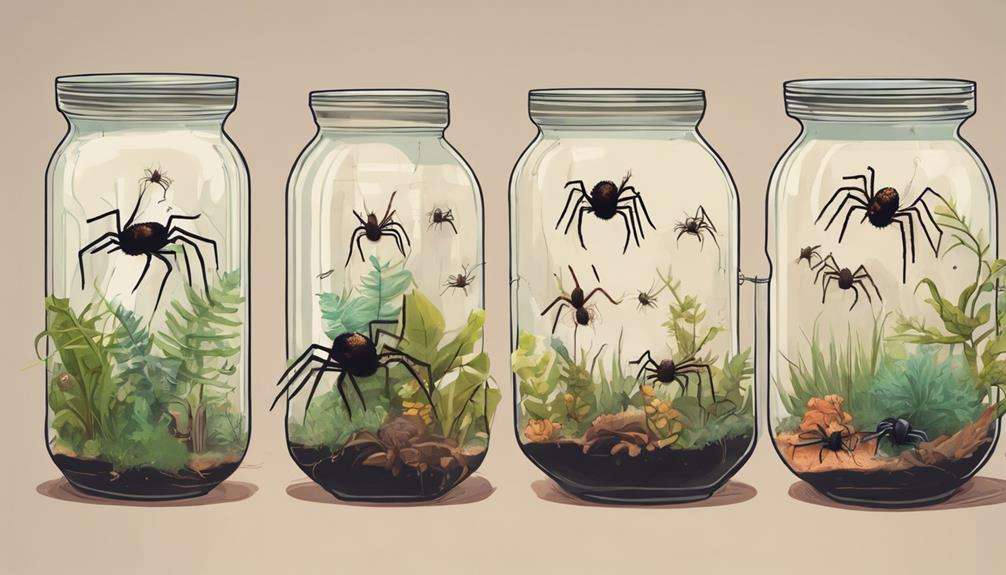Imagine a spider terrarium as a vital home for your eight-legged companion, providing a world tailored to their needs. But have you pondered why these enclosures are essential for your pet spiders?
The answer lies in the intricate balance they offer between functionality and creature comfort, ensuring a conducive environment that mirrors their natural habitat. Within these glass walls, a spider's well-being and behavior are intricately tied to the elements carefully curated to mimic their wild surroundings.
So, let's unravel the importance of spider terrariums for your arachnid friends.
Key Takeaways
- Terrariums regulate temperature, humidity, and provide a secure space for pet spiders.
- They aid in observing spider behavior, health, and offer suitable environments for different species.
- Proper terrarium setup mimics natural habitats, promoting physical and mental well-being.
- Regular cleaning and maintenance ensure a healthy, stimulating environment for pet spiders.
Benefits of Using Spider Terrariums
Spider terrariums offer a controlled environment that's essential for regulating temperature and humidity levels, ensuring the well-being of your pet spiders. These enclosures provide a secure space that shields your pet spiders from potential predators, guaranteeing their safety in captivity.
Additionally, spider terrariums enable you to easily observe and monitor your pet spider's behavior, health, and activity levels, aiding in the early detection of any issues. For web-building species, these terrariums offer a suitable environment for them to engage in their natural behaviors, such as constructing intricate webs.
Furthermore, spider terrariums not only serve a functional purpose but also enhance the visual appeal of your living space by showcasing your pet spider in a engaging display. By investing in a spider terrarium, you prioritize your pet spider's well-being while creating an aesthetically pleasing environment for both you and your arachnid companion.
Essential Elements in Spider Terrariums
To create an ideal habitat for your pet spider, it's essential to incorporate essential elements into the terrarium that mirror its natural environment. Spider terrariums must provide suitable substrate, such as peat moss or coconut fiber, to mimic the forest floor where spiders often reside. Including hiding spots, such as artificial plants or pieces of bark, allows your spider to retreat and feel secure. Climbing opportunities, like branches or cork bark, cater to arboreal species and fulfill their natural instincts.
Proper ventilation within spider terrariums is important for maintaining air quality and preventing the buildup of excess moisture, which could lead to respiratory issues for your pet. When it comes to lighting, keep it minimal as most spiders are nocturnal creatures and prefer dim environments to thrive. Ensuring cleanliness in the terrarium is paramount to prevent the growth of harmful bacteria, mold, or parasites that could endanger your spider's health. By incorporating these elements, you can provide a comfortable and safe home for your pet spider.
Choosing the Right Terrarium Size
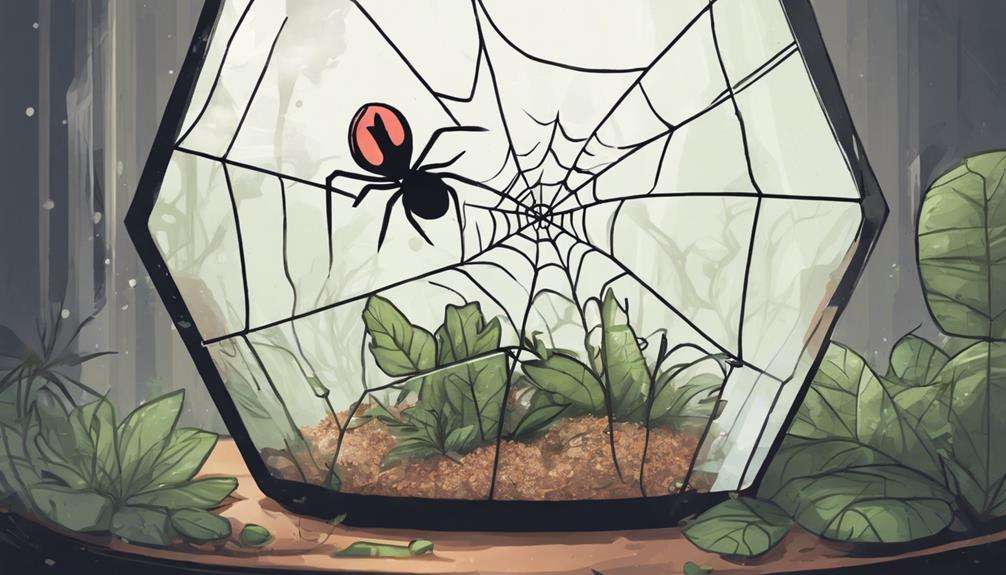
Selecting the appropriate terrarium size is an important factor in providing a comfortable and enriching environment for your pet spider. The size of the spider terrarium is vital, with most pet spiders requiring a tank around 10 gallons for best space and comfort.
Larger terrariums offer more room for decor, hiding spots, and climbing opportunities, enhancing the spider's environment. It's essential to take into account the natural behaviors of your specific spider species when determining the tank size. Arboreal spiders thrive in vertical terrariums, while terrestrial spiders prefer horizontal setups to mimic their natural habitats.
By choosing the right terrarium size, you guarantee that your spider has enough space to move around freely and exhibit its natural behaviors. Providing the best space promotes your spider's well-being, reduces stress, and supports a healthier and more enriching pet ownership experience.
Proper Ventilation for Terrariums
How can proper ventilation in terrariums impact the health and well-being of pet spiders?
Adequate ventilation in spider terrariums plays a critical role in maintaining ideal airflow and controlling humidity levels. Proper ventilation assists in regulating the temperature within the terrarium, ensuring a comfortable environment for spiders to thrive. Inadequate airflow can result in respiratory issues for spiders and create a breeding ground for harmful bacteria and fungi, which can compromise their health.
By incorporating ventilation holes or mesh openings, air circulation is promoted, reducing the risk of mold and mildew formation. Well-ventilated terrariums closely replicate the natural habitat of spiders, supporting their overall well-being and health.
Ensuring proper ventilation in terrariums is essential for creating a balanced environment that mimics the conditions spiders require for thriving in captivity.
Ideal Lighting for Spider Enclosures

To guarantee the well-being of your pet spiders, understanding their specific lighting needs is vital. Spider terrariums should balance natural and artificial light sources to mimic their natural habitat.
Establishing a consistent light schedule is essential for regulating spider behavior and promoting overall health in captivity.
Lighting Needs for Spiders
Spider terrariums for pet spiders require specific lighting conditions to replicate their natural habitat and support their activity patterns. Spiders thrive in low light levels, with many species being nocturnal or crepuscular.
To provide suitable illumination without overheating, opt for full spectrum LED lights or low wattage incandescent bulbs. UVB lighting is generally unnecessary as spiders don't require specific UV exposure.
Mimicking natural day and night patterns with a 12-hour light and 12-hour dark cycle helps regulate their activity and rest. Incorporating hiding spots and plants in the terrarium can aid spiders in managing their light exposure and create a comfortable environment that resembles their natural habitat.
Natural Vs Artificial Light
When considering the ideal lighting for spider enclosures, prioritize natural light for its provision of essential UVB rays important for spider health and well-being. UVB light plays an important role in the synthesis of vitamin D3 in spiders, which is critical for calcium absorption and overall metabolic functions.
While artificial light can supplement natural light in spider terrariums, it shouldn't be the primary source of lighting. Different spider species have varying light requirements, so it's important to research and provide suitable lighting conditions.
Excessive artificial light in spider enclosures can disrupt their natural circadian rhythm, potentially leading to stress among the spiders. Striking a balance between natural and artificial light is important for maintaining the well-being of pet spiders.
Light Schedule for Spiders
For maintaining peak health and behavior in pet spiders, establishing a consistent light schedule in their terrariums is essential. Since spiders are nocturnal creatures, mimicking natural day-night cycles with 10-12 hours of light per day is important for regulating their internal clocks.
LED or fluorescent lights equipped with adjustable timers are ideal for spider enclosures, ensuring a stable light cycle that supports proper activity and rest periods. Avoid subjecting spiders to excessive or direct sunlight, as it can lead to stress and overheating in their terrariums.
Maintaining a suitable light schedule is important for the well-being, behavior, and biological rhythms of spiders, helping them thrive in their captive environment.
Maintaining Optimal Humidity Levels
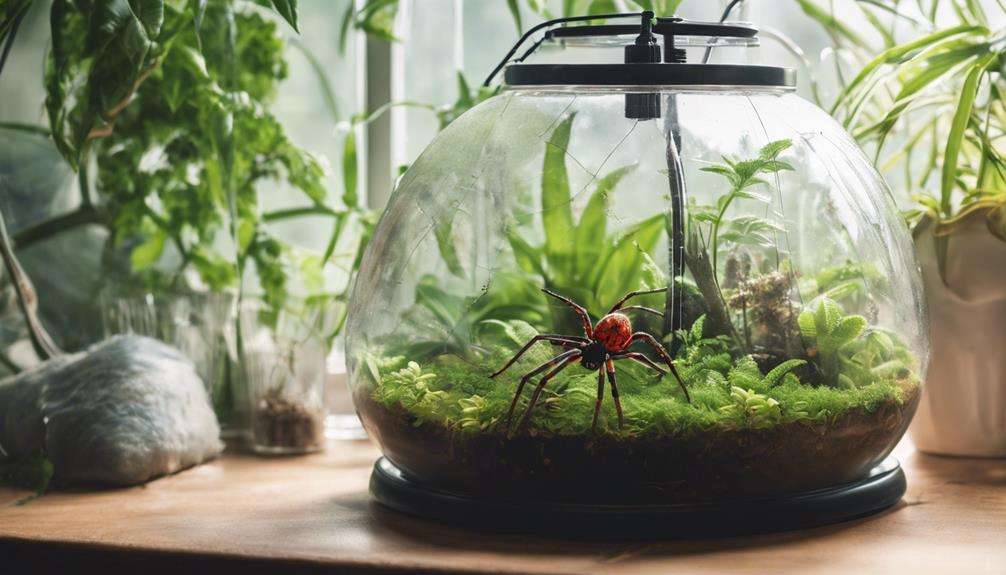
Maintaining the ideal humidity levels in your spider terrarium is important for the health and well-being of your pet spiders.
Humidity levels within the terrarium play a critical role in replicating the natural environment of the spider species, supporting proper respiratory function. Incorrect humidity levels can result in dehydration, molting issues, and increased stress for your pet spiders.
To prevent these issues, it's crucial to regularly monitor and adjust the humidity levels within the terrarium. By ensuring the humidity remains at the perfect level, you can help prevent health problems and promote the comfort of your pet spiders.
Proper humidity regulation also supports healthy molting cycles, contributing to the overall longevity of your spider companions. Remember, maintaining the right humidity levels is key to creating a thriving habitat for your pet spiders.
Selecting Suitable Substrate for Terrariums
To guarantee the top health and well-being of your pet spiders, selecting the right substrate for your terrarium is essential. The substrate in a spider terrarium serves as the foundation where the spider can engage in essential activities such as burrowing, molting, and constructing webs.
Suitable substrates for pet spiders, such as coconut fiber, peat moss, vermiculite, and potting soil, offer a natural environment and best moisture retention important for their health. It's important to avoid harmful substrates like sand, gravel, or cedar chips that can pose risks to spiders, potentially causing respiratory issues.
Keeping the substrate clean and dry is crucial to prevent mold growth and maintain a healthy environment within the spider terrarium. Different spider species may exhibit specific substrate preferences based on their natural habitat and behaviors, so research is necessary to guarantee the ideal substrate choice for your spider pet.
Decorating Spider Habitats Creatively
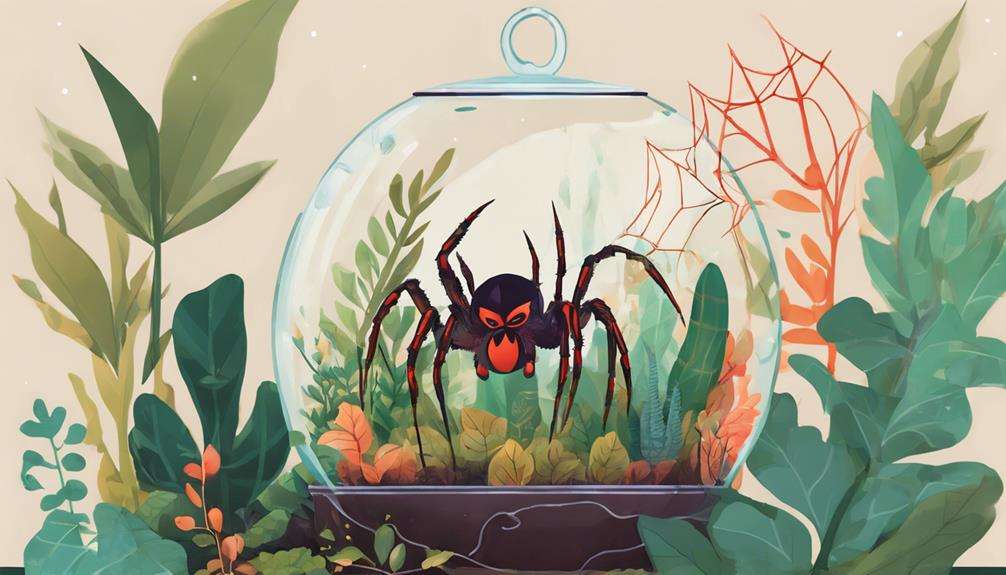
Choosing the suitable decorations for spider terrariums can greatly enhance the visual appeal and enrichment of your pet spiders' habitat. Mimicking natural habitats within the terrarium can provide stimulation and enrichment for your pet spiders. Consider adding live or artificial plants, branches, rocks, and caves to create a more natural environment. These elements offer hiding spots and climbing opportunities, essential for maintaining a healthy and engaging habitat. Utilizing textures like cork bark, moss, and silk plants can further enhance the habitat's appeal and provide a more realistic setting for your pet spiders.
To add a unique touch to the spider terrarium, consider customizing it with themed decorations such as miniature skulls, skeletons, or other spooky elements. These additions not only create a visually appealing environment but also offer enrichment through novel stimuli. Incorporating appropriate lighting, like low-wattage bulbs or LED lights, can further enhance the visual appeal of the spider terrarium, creating a fascinating space for both you and your pet spiders to enjoy.
Temperature Regulation in Terrariums
Make sure you maintain ideal heat levels inside the terrarium to support your spider's metabolic processes.
Consistently monitoring and adjusting humidity levels is key for creating a comfortable environment.
Proper temperature regulation is essential for the overall health and well-being of your pet spider.
Optimal Heat Levels
Maintaining ideal heat levels in spider terrariums is essential for the health and well-being of pet spiders. Temperature regulation is vital as it directly impacts spider metabolism, digestion, activity levels, and overall physiological functions.
To create a thermally stable environment, terrariums should be equipped with suitable heating elements such as heat mats or bulbs. The temperature within the terrarium should typically range between 70-85 degrees Fahrenheit to mimic the spiders' natural habitat.
Monitoring and controlling temperature fluctuations is paramount to prevent stress, illness, or death in pet spiders. By ensuring perfect heat levels, you can help your pet spider thrive and lead a healthy life within its terrarium.
Maintaining Humidity Levels
To create an ideal environment for pet spiders, humidity levels in terrariums must be carefully regulated to support their health and molting processes. Spider terrarium setups should cater to the specific humidity requirements of different spider species.
Inadequate humidity levels can result in dehydration, causing molting difficulties and health issues for pet spiders. Proper humidity regulation is important for mimicking the spiders' natural habitat and ensuring successful molting.
Additionally, maintaining appropriate humidity levels in terrariums is essential for the overall well-being of pet spiders, as it impacts their metabolic functions and activity levels. Hence, monitoring and adjusting humidity levels in spider terrariums play an important role in safeguarding the health and vitality of pet spiders.
Cleaning and Maintenance Tips
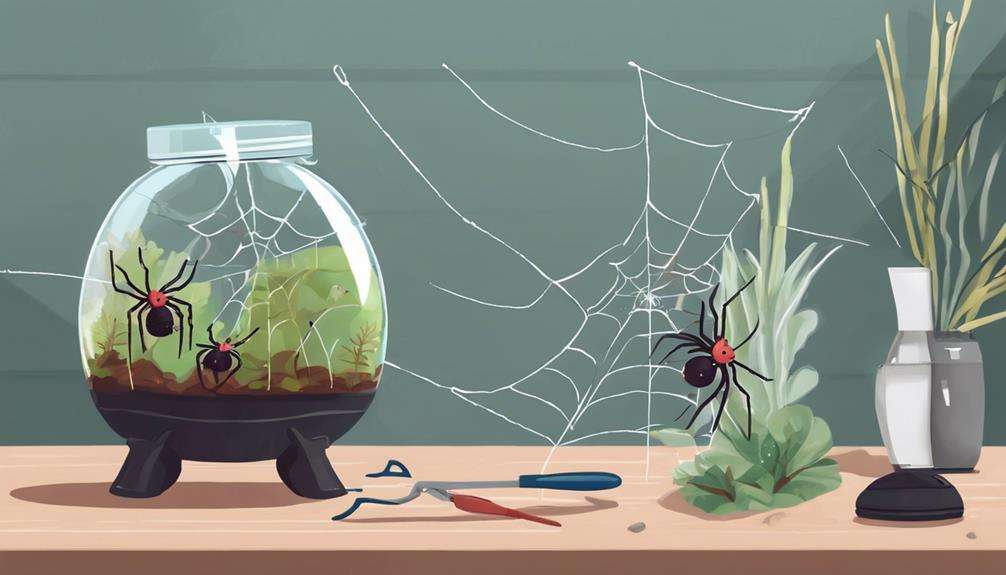
Regularly cleaning your spider terrarium is essential to prevent mold, bacteria, and mite infestations that could harm your pet spider.
Maintenance tasks such as spot cleaning feces, removing uneaten prey, and replacing substrate are important for maintaining a hygienic environment.
Proper ventilation within the terrarium is crucial as it helps regulate humidity levels and prevents stagnant air, reducing the risk of respiratory issues for your spider.
It's also important to check for any signs of wear or damage in the terrarium components to guarantee a safe and secure habitat for your pet.
Establishing a consistent cleaning schedule promotes the overall health and well-being of your pet spider, reducing stress and minimizing disease risks.
Frequently Asked Questions
What Do Spiders Need in Their Enclosure?
In their enclosure, spiders need proper humidity levels, temperature control, hiding spots, ventilation, suitable substrate choices, a feeding schedule, access to water, appropriate lighting options, a cleaning routine, and enrichment activities to thrive.
What Do Pet Spiders Need?
To guarantee the well-being of your pet spider, you must regulate temperature, humidity, and ventilation in their terrarium. Choose appropriate substrate, provide hideaways and climbing spots, establish a feeding schedule, offer water, maintain cleanliness, and include enrichment activities for their health.
Why Are Spiders Kept as Pets?
Spiders are kept as pets for their fascinating behavior, unique physical attributes, and impressive hunting techniques. They offer educational value, therapeutic benefits, and serve as conversation starters. Observing them can help dispel misconceptions and provide relaxation.
Do Pet Spiders Like to Be Held?
Pet spiders, like tarantulas, prefer minimal handling. Handling can stress them out, leading to injuries. They feel more comfortable in their terrariums, exhibiting natural behaviors. Some species have urticating hairs for defense, making handling uncomfortable.
Conclusion
To sum up, spider terrariums are essential for the well-being of pet spiders. These enclosures provide the necessary elements for their health and comfort, such as proper ventilation, lighting, substrate, and temperature regulation.
By creating a safe and stimulating environment, spider terrariums guarantee that your eight-legged friends thrive and flourish. Remember, a well-designed terrarium is like a cozy home for your spider, where they can spin their webs of happiness and contentment.

